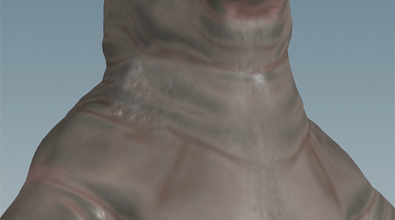michiel Hagedoorn
michiel
About Me
Connect
LOCATION
Not Specified
ウェブサイト
Houdini Skills
Availability
Not Specified
Recent Forum Posts
FEM and Vellum as mutual affectors? 2024年4月18日9:18
To achieve the best possible results for a two-way interaction like this, I would recommend using only a single solver for the entire setup.
You could use either FEM or Vellum, whatever your preference is.
For the bra, I would recommend creating a tube-shaped polygon mesh around the body.
This tube could have collisions turned off and interact with the body using attach and/or slide constraints, which are available in some form on both solvers.
You could use either FEM or Vellum, whatever your preference is.
For the bra, I would recommend creating a tube-shaped polygon mesh around the body.
This tube could have collisions turned off and interact with the body using attach and/or slide constraints, which are available in some form on both solvers.
FEM Slide constraint state error 2024年3月8日14:03
The error you're getting here is a bit deceiving.
The actual problem is that the ground plane is being run through the FEM solver, which doesn't know how to solve ground planes.
As a result, the solve fails, and as a side effect of the solve failing, the error that you're seeing shows up.
To quickly fix this network, delete the ground plane and add a new ground plane using the Ground Plane shelf tool in the Collisions tab.
The quickest way to learn more about FEM is to use the shelf tools and look into the DOP setups that they create.
It's also worth looking at the user guide for "finite elements" in our help docs.
Most aspects of an FEM simulation can be controlled by means of SOP attributes, which are discussed in the help of the FEM Solver node.
I hope this helps
The actual problem is that the ground plane is being run through the FEM solver, which doesn't know how to solve ground planes.
As a result, the solve fails, and as a side effect of the solve failing, the error that you're seeing shows up.
To quickly fix this network, delete the ground plane and add a new ground plane using the Ground Plane shelf tool in the Collisions tab.
The quickest way to learn more about FEM is to use the shelf tools and look into the DOP setups that they create.
It's also worth looking at the user guide for "finite elements" in our help docs.
Most aspects of an FEM simulation can be controlled by means of SOP attributes, which are discussed in the help of the FEM Solver node.
I hope this helps
In FEM, how could I get rid of edginess shapes...? 2018年8月7日9:56
There are several ways to control and influence the look of your fractured surfaces with FEM.
Using an embedded tet mesh can help. You can manipulate the embedded tet mesh to get a look that you want for your fractured surfaces without impacting the sim very much.
The best option for directly controlling the shape of the fractured surfaces is to use the fracturepart primitive attribute. This allows you to create little chunks (fracture parts) that won't get separated no matter what happens. The fracturing remains dynamic, however it is restricted such that it does not fracture between tets that have the same fracturepart value. The Solid Fracture SOP creates such a fracturepart attribute for you, but you can create the attribute yourself if you like. If you use fracturepart to create fairly round parts then you'll avoid the edgy shapes that you're seeing.
You can take a look at what the Fractured Solid Object shelf tool does with regards to the embedded setup and the creation of a fracturepart attribute.
Using an embedded tet mesh can help. You can manipulate the embedded tet mesh to get a look that you want for your fractured surfaces without impacting the sim very much.
The best option for directly controlling the shape of the fractured surfaces is to use the fracturepart primitive attribute. This allows you to create little chunks (fracture parts) that won't get separated no matter what happens. The fracturing remains dynamic, however it is restricted such that it does not fracture between tets that have the same fracturepart value. The Solid Fracture SOP creates such a fracturepart attribute for you, but you can create the attribute yourself if you like. If you use fracturepart to create fairly round parts then you'll avoid the edgy shapes that you're seeing.
You can take a look at what the Fractured Solid Object shelf tool does with regards to the embedded setup and the creation of a fracturepart attribute.
